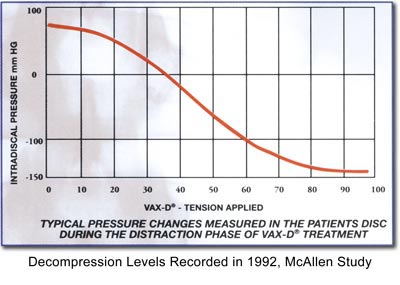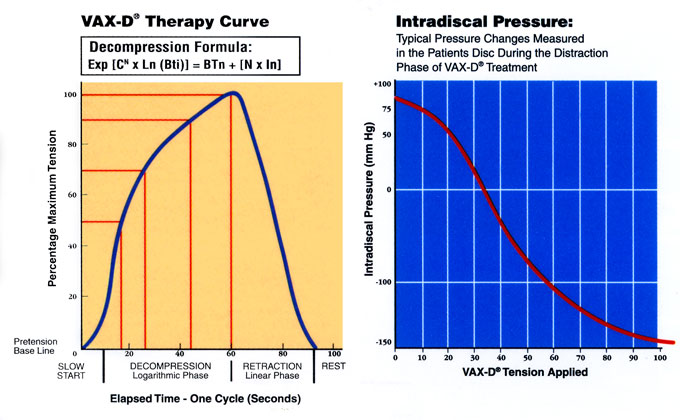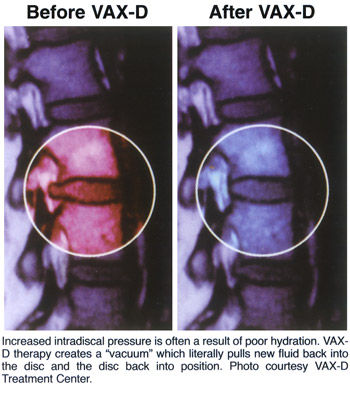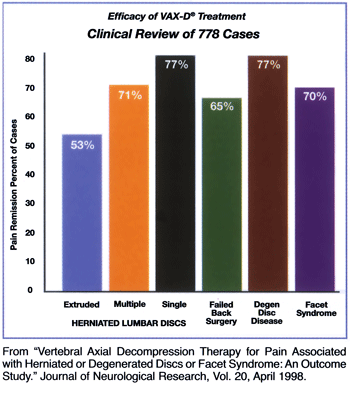 |
Introduction
Low back pain and associated symptoms caused by suspected and/or confirmed herniated discs is a persistent problem in every practice.
At Dallas Back ICU, we employ the most advanced treatment methods and procedures for the (non-surgical) treatment of these debilitating conditions.
Vertebral Axial Decompression treatment is just one of the new FDA approved Class II medical procedures employed for the treatment of low back pain resulting from herniated discs.
 Research conducted by Dr. G. Ramos at the Rio Grande Regional Hospital at McAllen, Texas for the FDA in the early 90's, established the medical fact that treatment by the Vax-D® Machine does produce negative intradiscal pressure in the lumbar spine during treatment. It is this decompression of the discs which results in increased hydration and replenishment of regenerative elements to the disc resulting in recovery for most patients. Research conducted by Dr. G. Ramos at the Rio Grande Regional Hospital at McAllen, Texas for the FDA in the early 90's, established the medical fact that treatment by the Vax-D® Machine does produce negative intradiscal pressure in the lumbar spine during treatment. It is this decompression of the discs which results in increased hydration and replenishment of regenerative elements to the disc resulting in recovery for most patients.
How it Works
In simple terms Vax-D® is an FDA-approved, computer-assisted method for developing negative intradiscal pressure in the lumbar spine. It was developed in the 1980s and patented by Allan E. Dyer, M.D., Ph.D., who also pioneered development of the CARDIAC DEFIBRILLATOR.
At the heart of Vax-D® therapy is a sophisticated table on which the patient lies during the 30-minute procedure. “The table distracts the lumbar region. It utilizes a highly sensitive computerized device that senses muscles spasm and tension and gently coaxes muscles to relax and lengthen, allowing decompression of the lumbar discs.”
During a Vax-D® therapy session, the patient lies prone with the upper body positioned over the stationary portion of the two-part table. The patient is held in place comfortably by a chest harness. The computer then monitors spinal decompression during distraction of the vertebral column which is accomplished through the waist harness. Throughout the procedure, the patient remains very comfortable and often falls asleep as symptoms reduce. The procedure is conducted by a certified Vax-D® technician.

 Why It Works Why It Works
Patients whose natural regeneration process has broken down, for whatever reason, can be helped by Vax-D®. Vertebral Axial Decompression can decompress the discs of the spine to a level of up to minus 150 mmHg. Evidence suggests the process causes bulging or herniated discs to retract, taking pressure off the nerve roots.
“What you've created, then, is essentially a vacuum within the injured disc. In the process of doing so, Vax-D® makes it possible for the disc to draw in the body's own cell regeneration materials – nutrients and oxygen. In essence, it accelerates the body's own restabilization and restrengthening process within the lumbar discs.” (R.L. Hohn, M.D. News SD Regional Edition, January 2003.)
In fact, the largest study yet conducted on Vax-D® concluded that Vertebral Distractions (increased separation) of even 1 or 2 mm per disc have the power to “reduce ligamental redundancy and help to restore canal/foraminal patency, reduce venous congestion and increase axoplasmic flow.” (Neurological Research, Volume 20, No. 3, April 1998, pp. 186)
The Evidence
 The evidence for the efficacy of Vax-D® is strong. In a 1998 University of Illinois study of 778 patients, 71 percent demonstrated a reduction in symptoms to 0 or 1 on a scale of 0 to 5 after a course of Vax-D® therapy. 77 percent of patients with a single herniated disc experienced such reduction in symptoms. The symptom elimination rate in test subjects with multiple herniation was 71 percent. 77 percent of study participants suffering from degenerative disc disease also experienced total elimination of their symptoms. The success rate for facet syndrome was 70 percent. The study even found Vax-D® to be successful for 53 percent of those with extruded herniation. (Neurological Research, 20, 3, pp. 186-190.) The evidence for the efficacy of Vax-D® is strong. In a 1998 University of Illinois study of 778 patients, 71 percent demonstrated a reduction in symptoms to 0 or 1 on a scale of 0 to 5 after a course of Vax-D® therapy. 77 percent of patients with a single herniated disc experienced such reduction in symptoms. The symptom elimination rate in test subjects with multiple herniation was 71 percent. 77 percent of study participants suffering from degenerative disc disease also experienced total elimination of their symptoms. The success rate for facet syndrome was 70 percent. The study even found Vax-D® to be successful for 53 percent of those with extruded herniation. (Neurological Research, 20, 3, pp. 186-190.)
“We consider Vax-D® therapy to be a primary treatment modality for low back pain associated with lumbar disc herniation at a single or miltiple levels, degenerative disc disease, facet arthropathy, and decreased spine mobility,” wrote authors and neurologists Earl E. Gose, William K. Naguszewski and Robert K. Naguszewski. “Successful reduction of intradiscal pressures with Vax-D® therapy represents a technological advance in lubar spinal treatment,” wrote the authors. “Creating negative intradiscal pressure is likely to affect both the biomechanical and biochemical causes of discogenic pain. The results from this study demonstrate that Vax-D® is an effective treatment for the management of patients with chronic low back pain.” (Neurological Research, Volume 23, October 2001, p. 783.)
“Our medical director assesses each patient's MRIs and their history before we start any treatment. We also work closely with each patient's attending physician before, during, and after Vax-D® therapy.” Patients who are deemed to be good candidates for Vax-D® typically undergo between 20 and 20 30-minute procedures on consecutive days. “The number of treatments will vary with the condition and age of the patient.”
For more information on Vax-D® therapy, visit the Vax-D® Web site at vaxd.com.
Testimonials
|
Robert Channey, M.D.,
Assistant Surgeon General of the United States
"I had a back problem in 1977. We found that the discs had deteriorated at the l4-L5 and L5-S1 area. In July of 1993, I ended up with excruciating pain in my back. They recommended that I start on VAX-D.... after the fifteenth session I only had a slight twinge occasionally. Since that day on, I am completely free of the pain in my back and my left leg." |
|
Tracy McGrady,
Houston Rockets
In August 2002, Tracy McGrady, scared and confused, wondered whether surgery was the only way to relieve his aching back.
"It was so bad, I almost didn't play the first game. I came down after scoring and experienced more pain than I've ever had..."
"Before this, it was real frustrating," McGrady said. "I hadn't found the answer, but now I feel good."
|
 |
|
Bruce Wilkerson,
Green Bay Packers
Bruce Wilkerson is a veteran NFL offensive lineman with the Green Bay Packers. "If I would of known about VAX-D I might still be playing. Years of playing football had caught up with my body. The pain kept me from being at my best."
"My father told me about a new treatment called VAX-D. It has changed my life. My daily activities are back to normal."
|
|
Sandra Fallico, M.D.,
Radiologist, Gottlieb Memorial Hospital, Melrose Park, Illinois
"I was so impressed with the many positive results that I sent my husband for treatment. He had severe back pain for many years, which was predominantly secondary to bony facet disease, with mild disc disease. He is a hardcore golf fanatic, and was incapacitated by his back pain. He underwent a full series of VAX-D treatments and has been virtually asymptomatic for five years."
|
|
(Orlando Sentinel, 2002)
|
|
 |

